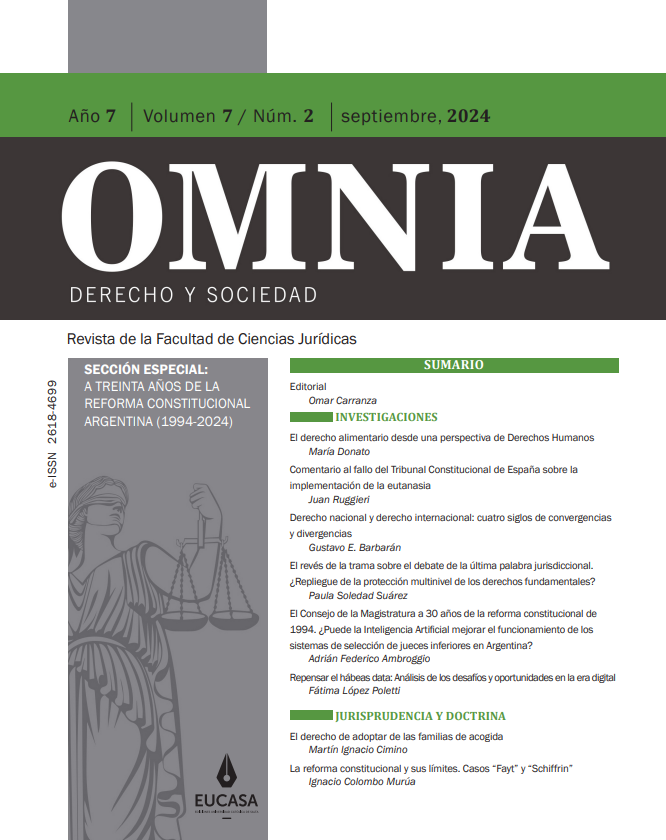The constitutional reform and its limits. “Fayt” y “Schiffrin” cases
Abstract
The 1994 reform faced, for the first time in Argentine constitutional history, the jurisdictional declaration of nullity of one of the articles incorporated by the Constituent Convention. In fact, art. 99 inc. 4, relating to the duration of judges in office, was invalidated in the “Fayt” precedent. However, in a new ruling, “Schiffrin”, the Supreme Court of Justice of the Nation reestablished its validity. This inevitably leads us to reflect, on the one hand and in general, on the limits to constitutional reforms; and, on the other hand, on what is the specific issue that motivated so many ups and downs and conflicts when it came to interpreting and applying our reformed Constitution. In this work, then, the constitutional reform process, its limits and the ups and downs that occurred in relation to the constitutionality of the article in question will be critically addressed. Within this framework, it will seek to reach conclusions regarding the meaning and scope of the constitutional reform process.
Downloads
References
Badeni, G. (2000). Instituciones de derecho constitucional. Ad-Hoc.
Colombo Murúa, I (2011). Límites a las reformas constitucionales. Astrea.
De Vega García, P. (1985). La reforma constitucional y la problemática del poder constituyente. Tecnos.
Diaz Ricci, Sergio (2004). Teoría de la reforma constitucional. Ediar.
Ferreyra, G. R. (2007). Reforma constitucional y control de constitucionalidad. Ediar.
Holmes, S. (1999). El precompromiso y la paradoja de la democracia, en Elster, J. y Slagstad, R. (Coords.), Constitucionalismo y democracia. Fondo de Cultura Económica.
Elster, J. (2002). Ulises desatado. Estudios sobre racionalidad, precompromiso y restricciones. Gedisa.
Gargarella, R. (2014). La sala de máquinas de la constitución. Dos siglos de constitucionalismo en América Latina (1810-2010). Katz.
Gelli, M. A. (2013). Constitución de la Nación Argentina. Comentada y concordada. 4.° ed., Tomo I. La Ley.
Linares Quintana, S. V. (1953). Tratado de derecho constitucional. Editorial Alfa.
Mouffe, C. (2003). La paradoja democrática. Gedisa.
Prieto Sanchís, L. (2003). Justicia constitucional y derechos fundamentales. Trotta.
Quiroga Lavié, H. (1978). Derecho constitucional. Cooperadora de Ciencias Sociales.
Requejo Pagés, J. L. (1998). Las normas preconstitucionales y el mito del poder constituyente. CEPC.
Riberi, P. (2011). Límites del poder constituyente: subjetividades y agonías del criptoconstitucionalismo, en AA. VV. Nuñez Leiva, J. I., Nuevas perspectivas en derecho público, pp. 91-144. Librotécnica.
——— (2008). Poder constituyente derivado, un mito del criptoconstitucionalismo [ponencia]. Jornadas Argentino, Chileno, Peruanas de Asociaciones de Derecho Constitucional, Buenos Aires.
Sieyès, E. (1973). ¿Qué es el tercer Estado? Aguilar.
Vanossi, J. R. (2000). Teoría constitucional. Depalma.
Von Ihering, R. (1993). En el Cielo de los conceptos jurídicos: una fantasía, en La picaresca jurídica universal. Gustavo Ibáñez.
——— (1987). Bromas y veras en la ciencia jurídica. Civitas.
Zagrebelsky, G. (2005). El derecho dúctil. Ley, derechos, justicia (trad. María Gascón). Trotta.
Copyright (c) 2024 Ignacio Colombo

This work is licensed under a Creative Commons Attribution-NonCommercial-ShareAlike 4.0 International License.







